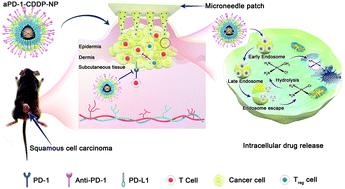Our official English website, www.x-mol.net, welcomes your
feedback! (Note: you will need to create a separate account there.)
Microneedles loaded with anti-PD-1-cisplatin nanoparticles for synergistic cancer immuno-chemotherapy.
Nanoscale ( IF 5.8 ) Pub Date : 2020-09-09 , DOI: 10.1039/d0nr04213g Xinmiao Lan 1 , Wangyong Zhu , Xinshuo Huang , Yingjie Yu , Haihua Xiao , Lijian Jin , Jingya Jane Pu , Xi Xie , Juncong She , Vivian Wai Yan Lui , Hui-Jiuan Chen , Yu-Xiong Su
Nanoscale ( IF 5.8 ) Pub Date : 2020-09-09 , DOI: 10.1039/d0nr04213g Xinmiao Lan 1 , Wangyong Zhu , Xinshuo Huang , Yingjie Yu , Haihua Xiao , Lijian Jin , Jingya Jane Pu , Xi Xie , Juncong She , Vivian Wai Yan Lui , Hui-Jiuan Chen , Yu-Xiong Su
Affiliation

|
Programmed cell death protein-1 (PD-1) on T-cells combined with programmed cell death ligand-1 (PD-L1) critically accounts for tumor immune evasion. Anti-PD-1 (aPD-1) blocks the binding of PD-1 to PD-L1, thus allowing T-cell activation for tumor cell eradication. Currently, the major challenges for cancer immunotherapy are how to improve the response rate and overcome drug resistance. Dermal administration turns out to be a promising route for immunotherapy since skin is a highly active immune organ containing a large population of resident antigen-presenting cells. Microneedle arrays can pierce the immune-cell-rich epidermis, leading to a robust T-cell response in the microenvironment of tumor cells. Herein, we successfully developed a microneedle patch loaded with pH-responsive tumor-targeted lipid nanoparticles (NPs), which allows local delivery of aPD-1 and cisplatin (CDDP) precisely to cancer tissues for cancer therapy. For in vivo studies, aPD-1/CDDP@NPs delivered through microneedles effectively boosted the immune response, thereby a remarkable effect on tumor regression was realized. Synergistic anticancer mechanisms were therefore activated through robust microneedle-induced T-cell response, blockage of PD-1 in T-cells by aPD-1, and an increase in direct cytotoxicity of CDDP in tumor cells. Strikingly, transdermal delivery using MNs increased the response rate in the animal model unresponsive to aPD-1 systemic therapy. This exhibited promise in the treatment of immunotherapy-unresponsive cancers. Taken together, microneedle-mediated local delivery of nano-encapsulated chemotherapeutic and immunotherapeutic agents at tumor skin sites provides a novel treatment strategy and insights into cancer therapy.
中文翻译:

装有抗PD-1-顺铂纳米粒子的微针,用于协同癌症免疫化学疗法。
T细胞上的程序性细胞死亡蛋白-1(PD-1)与程序性细胞死亡配体-1(PD-L1)结合,可以关键地逃避肿瘤免疫。抗PD-1(aPD-1)阻断了PD-1与PD-L1的结合,从而允许T细胞活化以消灭肿瘤细胞。当前,癌症免疫疗法的主要挑战是如何提高应答率和克服耐药性。由于皮肤是一种高度活跃的免疫器官,其中包含大量的驻留抗原呈递细胞,因此经皮给药已成为免疫疗法的一种有希望的途径。微针阵列可以刺穿富含免疫细胞的表皮,从而在肿瘤细胞的微环境中产生强大的T细胞反应。在此,我们成功开发了装有pH响应性肿瘤靶向脂质纳米颗粒(NPs)的微针贴剂,可以将aPD-1和顺铂(CDDP)精确地局部递送至癌症组织进行癌症治疗。对于在体内研究中,通过微针递送的aPD-1 / CDDP @ NPs有效地增强了免疫反应,从而实现了对肿瘤消退的显着效果。因此,通过强大的微针诱导的T细胞反应,aPD-1阻断T细胞中的PD-1以及增加肿瘤细胞中CDDP的直接细胞毒性,从而激活了协同抗癌机制。令人惊讶的是,使用MNs的透皮递送提高了对aPD-1全身治疗无反应的动物模型的反应率。这在免疫疗法无反应的癌症的治疗中显示出希望。综上所述,微针介导的在肿瘤皮肤部位纳米胶囊化的化学治疗剂和免疫治疗剂的局部递送提供了一种新颖的治疗策略和对癌症治疗的见解。
更新日期:2020-09-24
中文翻译:

装有抗PD-1-顺铂纳米粒子的微针,用于协同癌症免疫化学疗法。
T细胞上的程序性细胞死亡蛋白-1(PD-1)与程序性细胞死亡配体-1(PD-L1)结合,可以关键地逃避肿瘤免疫。抗PD-1(aPD-1)阻断了PD-1与PD-L1的结合,从而允许T细胞活化以消灭肿瘤细胞。当前,癌症免疫疗法的主要挑战是如何提高应答率和克服耐药性。由于皮肤是一种高度活跃的免疫器官,其中包含大量的驻留抗原呈递细胞,因此经皮给药已成为免疫疗法的一种有希望的途径。微针阵列可以刺穿富含免疫细胞的表皮,从而在肿瘤细胞的微环境中产生强大的T细胞反应。在此,我们成功开发了装有pH响应性肿瘤靶向脂质纳米颗粒(NPs)的微针贴剂,可以将aPD-1和顺铂(CDDP)精确地局部递送至癌症组织进行癌症治疗。对于在体内研究中,通过微针递送的aPD-1 / CDDP @ NPs有效地增强了免疫反应,从而实现了对肿瘤消退的显着效果。因此,通过强大的微针诱导的T细胞反应,aPD-1阻断T细胞中的PD-1以及增加肿瘤细胞中CDDP的直接细胞毒性,从而激活了协同抗癌机制。令人惊讶的是,使用MNs的透皮递送提高了对aPD-1全身治疗无反应的动物模型的反应率。这在免疫疗法无反应的癌症的治疗中显示出希望。综上所述,微针介导的在肿瘤皮肤部位纳米胶囊化的化学治疗剂和免疫治疗剂的局部递送提供了一种新颖的治疗策略和对癌症治疗的见解。











































 京公网安备 11010802027423号
京公网安备 11010802027423号